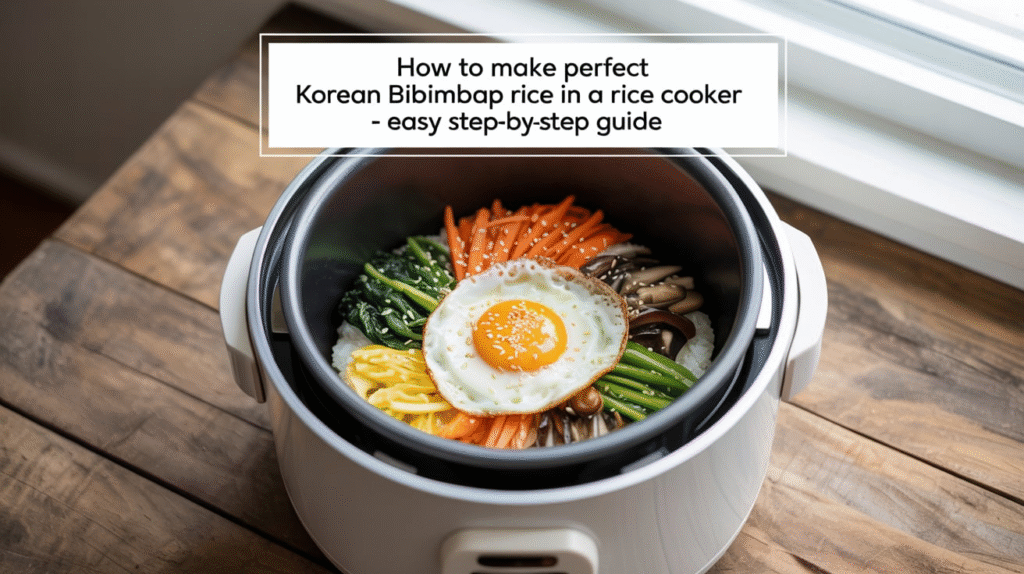Yes, you can make delicious Korean Bibimbap-style rice using just a rice cooker. By layering seasoned vegetables, marinated meat (or tofu), and a rich gochujang-based sauce over rice, this dish becomes a one-pot wonder, saving time while delivering authentic taste.

In this guide, you’ll learn exactly how to prepare Korean Bibimbap Rice in a rice cooker with simple ingredients and easy steps that work for both beginners and seasoned home cooks.
What Is Korean Bibimbap?
Bibimbap means “mixed rice” in Korean. It’s a traditional dish served with a variety of sautéed and seasoned vegetables (namul), meat (usually beef or chicken), and a spicy-sweet chili paste sauce (gochujang), all placed over warm rice. The dish is stirred just before eating, blending all flavors into one balanced, nourishing bowl.
Why Rice Cooker Bibimbap Works
Cooking Bibimbap in a rice cooker streamlines the preparation. It keeps the rice fluffy, the vegetables tender, and the meat juicy—without extra pans.
- No need for multiple skillets or sauté pans.
- The steam-infused environment retains authentic Korean flavor.
- Perfect for meal prepping or quick weekday dinners.
Ingredients You’ll Need for Bibimbap Rice
Gather these ingredients for an easy and customizable Bibimbap base. You can tweak them based on your preference.
- 2 cups of short-grain rice (rinsed and soaked for 30 mins)
- 1 cup spinach, blanched and squeezed
- 1 medium carrot, julienned
- 1 zucchini, julienned
- 4–5 shiitake mushrooms, thinly sliced
- 200g beef (or firm tofu), thinly sliced
- 1 egg per serving, for topping (optional)
- Sesame oil & seeds, for flavor and garnish
For the Bibimbap Sauce
This sauce brings it all together:
- 2 tablespoons gochujang (Korean chili paste)
- 1 tablespoon sesame oil
- 1 tablespoon rice vinegar
- 1 tablespoon honey or sugar
- 1 teaspoon minced garlic
Mix all together and set aside.
Step-by-Step Instructions
Use these steps to cook your Bibimbap entirely in a rice cooker.
Step 1: Prep the Rice Base
- Wash the rice until the water runs clear.
- Soak for 30 minutes to help achieve perfect texture.
- Drain and add to the rice cooker with equal parts water.
Step 2: Marinate and Prep the Meat or Tofu
- For beef: Marinate in soy sauce, garlic, sesame oil, and a bit of sugar.
- For tofu: Use the same mix, letting it absorb for 10-15 minutes.
Step 3: Layer Ingredients in the Rice Cooker
Place the vegetables and meat/tofu in sections on top of the soaked rice (do not mix yet).
- Add carrots, mushrooms, spinach, and zucchini in separate sections.
- Add marinated beef or tofu last.
- Drizzle 1 tbsp sesame oil over the top.
Step 4: Cook
- Start the regular white rice cycle.
- Once done, let it steam for 5 minutes before opening the lid.
Step 5: Serve and Mix
Spoon servings into bowls, top each with a fried or poached egg (optional), drizzle the prepared Bibimbap sauce, and mix well before eating.
Tips for Authentic Flavor
Follow these suggestions to elevate the dish:
- Use Korean short-grain rice for authentic texture.
- Add pickled radish or kimchi for a bolder punch.
- Toasted sesame seeds give a lovely crunch.
- For extra depth, let the bottom rice slightly crisp up (nurungji style).
Customization Ideas
Bibimbap is extremely adaptable. Consider these ideas:
- Vegan Version: Swap beef for tofu and skip the egg.
- Spicy Boost: Add extra gochujang or sliced red chili.
- Seafood Option: Use shrimp or squid, pre-cooked and layered on top.
- Low Carb: Substitute half the rice with cauliflower rice.
Storage and Reheating Tips
- Store leftovers in an airtight container for up to 3 days.
- Reheat in a microwave or skillet. Add a few drops of water to prevent drying out.
- Sauce should be stored separately if not mixed in.
FAQs About Korean Bibimbap Rice in a Rice Cooker
Here are some questions and answers about making Bibimbap-style rice in a rice cooker.
Can I make Bibimbap in any rice cooker?
Yes, you can use any standard rice cooker, but multifunctional ones with “mixed rice” or “brown rice” settings can yield even better texture.
Is it okay to mix the ingredients before cooking?
It’s best to layer ingredients and mix after cooking to maintain flavor and texture for each component.
What if I don’t have gochujang?
You can substitute with a mix of sriracha, miso paste, and a touch of sugar. However, gochujang is essential for authentic Korean flavor.
Can I cook an egg in the rice cooker too?
It’s possible to crack an egg on top during the last 5 minutes of cooking and let it steam. However, cooking separately ensures better results.
Is Bibimbap healthy?
Yes, it’s balanced with carbs, protein, and vegetables. It’s also customizable to fit various dietary needs.
This Bibimbap Rice in a rice cooker recipe is a perfect entry into Korean flavors without the hassle of multiple pans. Try it tonight and enjoy a hearty, colorful, and deeply satisfying bowl.